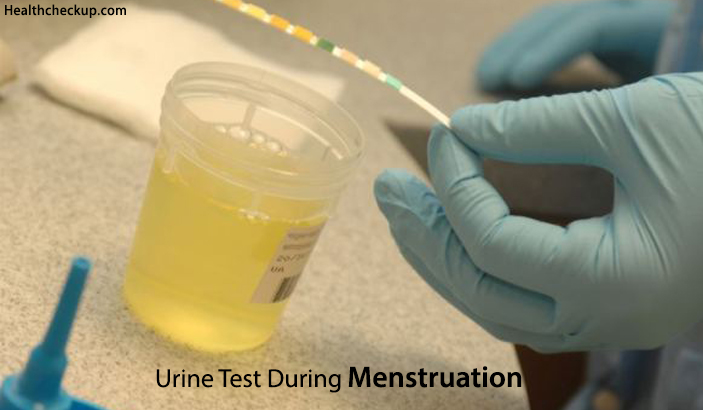A urine test is a common diagnostic test used to check the colour, clarity, odour, concentration, and the pH value of urine and many doctors are divided in their opinion about conducting a urine test during menstruation in women. In addition to checking the characteristics of urine. A urine test also checks the levels of sugar, blood cells, protein and other substances in the urine sample that may indicate various diseases. The urine test is also called a Urinalysis.
Urine is a waste product from the body that is produced by the kidneys. Usually, the waste products in the blood are filtered into the kidneys, and these waste products are passed from the kidney into the urinary bladder along with some fluids. Once the bladder is full, it eliminates the urine through the urethra. A membranous tube that extends from the urinary bladder to the exterior, thus eliminating the urine to the outside of the body.
What Is Urine Test for?
A urine test may be conducted as part of a routine physical examination. Sometimes it is ordered by the doctors to specifically
- Check for any disease or infection of the urinary tract that includes the kidneys, the ureters, which are tubes that carry urine from the kidney to the urinary bladder, and the urinary bladder. The urinary tract also includes the urethra, which is the tube that carries urine from the bladder to the outside of the body, as mentioned above.
- To evaluate the effects of the treatment of conditions such as diabetes, a urinary tract infection or UTI, kidney stones, hypertension and some diseases of the kidney and liver.
Can You Take a Urine Test on Your Period?
While menstruation is not a contraindication for a urine test, it is best to take the advice of a doctor before you take the urine test during menstruation. The doctor might want you to wait for a few days to conduct the test or start the treatment for any disease based on your history and physical examination, without conducting the urine test.
However, if your symptoms are severe and indicative of any kidney disease, such as frequent urination, painful urination, dizziness, swelling of the face, hands, and feet, and shortness of breath. The doctor may advise you to undergo a urine test during the period is right away to help diagnose the underlying cause of the symptoms.
Women undergoing menstruation should take extra care while collecting the urine sample for a urine test. Because the vagina and the urethra lie very close to each other. It makes it difficult to collect a urine sample without contaminating it with menstrual blood.
As mentioned earlier, the contamination of the urine sample with menstrual blood will lead to a false positive diagnosis and might lead the doctor to conclude that there is some damage in the urinary system, if he’s unaware of your menstruation.
Precautions For Urine Test During Menstruation
The best way to avoid menstrual blood from flowing into the urine sample is for a woman on her period to insert a fresh tampon, and cover the entrance of the vagina with a piece of clean cloth or any material that would absorb the blood, and avoid the contamination of the urine sample.
If you don’t want to use a tampon. Then you can collect the urine sample by placing the collection cup given by the lab as far enough away from the body. As possible to ensure that only the stream of urine will flow and collect in the cup without the entrance of the menstrual blood. Also, remember to submit the urine sample to the lab within one hour of collecting it.
Urinalysis or Urine Test Results Interpretation
Interpretation of urinalysis is generally based on reviewing all the components of the test and correlating it with the physical examination and symptoms of the patient. The urine results are reviewed and interpreted by the doctor who ordered the test.
The Urine Test or a Urinalysis Consists of Three Parts. They are
- Physical or Visual Examination of the Urine (also referred to as macroscopic analysis)
- Microscopic Examination
- Dipstick Test
Macroscopic Analysis
In the visual examination, the lab technician checks for the color and clarity of the urine. If urine has blood in it, it appears red or dark brown. Usually, a urine test during menstruation in women may cause a few drops of the menstrual blood to flow into the urine sample.
And if the doctor or the technician is unaware of the patient undergoing menstruation. Then he may make a false diagnosis due to the change in the urine color seen during the visual examination. Other changes in the urine sample such as foam or cloudiness in the urine may be seen in case of kidney disease or urinary tract infection, respectively.
Microscopic Analysis
The Microscopic Examination of the Urine Sample is Used to Look for
- Red blood cells (RBCs) it is usually abnormal to find RBCs in the urine in case of healthy individuals, but RBCs may be found in the urine during menstruation in a woman’s urine sample, thus leading to a false positive result
- White blood cells (WBCs)
- Bacteria
- Crystals which signify kidney stones
Dipstick Test
The third and final Part of the Urine Test is the Dipstick Test, which is the Chemical Test that helps determine the following
- The Acidity or pH of the Urine: The normal pH of urine is considered to be around 6, a pH value lower than 6 indicates the increase in acidity of the urine. It indicates the presence of kidney stones or a urinary tract infection (UTI). Menstruation has no bearing on the pH value of urine.
- Protein: The presence of protein in urine signifies the improper functioning of the kidneys. And other diagnostic procedures will be done to identify the underlying condition.
- Glucose: The presence of high levels of sugar in the urine is an indicator of diabetes. Again, menstruation does not affect the sugar levels in a urine sample.
- White Blood Cells: The presence of WBCs in urine indicates an infection, either in the body or just in the urinary tract.
- Blood: It is abnormal to find blood in urine. It indicates an infection or the presence of a severe illness in the body. Menstruation, however, causes blood to be present in urine. And it may lead to a false positive result of the urine test. if the person undergoing the urine test during menstruation does not inform the doctor or the lab technician, or is not careful enough to avoid blood drops from entering the urine sample while collecting it.
Thus, undergoing a urine test during menstruation is not a herculean task if you take the right steps. Talk to your doctor about any concerns you have regarding the risks involved with the test, the meaning of the test results, and when to expect the test results.
The urine test merely presents the warning signs of an underlying problem but does not help diagnose the specific condition that is causing the signs. And the doctor may order more specific diagnostic tests to identify any disease that is affecting your health and well-being.
Medically Reviewed By

I am an experienced Medical/Scientific writer with a passion for helping people live a happy healthy life. My thirst for writing has followed me throughout the years – it is there when I wake up, lingering at the edges of my consciousness during the day, and teases me at night as I go to sleep.










